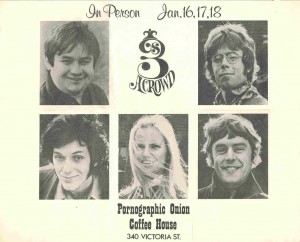
No. 95-1 Music 596-13
Toronto Metropolitan University is located next to Toronto’s legendary Yonge Street Strip which, despite its tawdry reputation, gained recognition in the 1960s and 1970s as a mecca for established and emerging musical artists and acts, in a wide variety of genres ranging from rhythm and blues to jazz, rock n’ roll and folk.Establishments such as the Colonial Tavern, the Bluenote, Friar’s Tavern, the Coq D’Or, Steeles Tavern and the Brown Derby served as important venues for internationally renowned performers as well as budding Canadian artists.
Despite its primary role as an educational institution, Ryerson played a part — albeit a minor one — in offering musicians an alternative place to perform.
One such place was the Ryerson Theatre which, when opened in 1964, was considered a prime Toronto venue for concerts, plays and other artistic performances.

January 14, 1969 No. 878-2
Another Ryerson locale, more in tune with the late 1960s but less grandiose in nature, was the Pornographic Onion coffee house. Established in late winter, 1968, by Radio and Television Arts students, it was initially planned as a three-day feature of the Ryerson Winter Carnival. It developed, however, into a more permanent setting for young, promising folk artists such as Bruce Cockburn, Lenny Breau, David Wilcox and Jerry Jeff Walker.
The Pornographic Onion appears to have been originally located in the old Underwood Building (where Jorgenson Hall and the Podium are situated today) but moved to the MGM Building when construction of the new Ryerson complex was begun. The coffee house survived into the winter of 1970, but closed due to the further expansion of the Institute (the MGM Building was demolished to make way for the construction of the Learning Resources Centre — or the Library Building as it is known today).In 2004, two items relating to both the Ryerson Theatre and the Pornographic Onion were donated to the Ryerson Archives by Ken Goodings, Video Media Systems Technologist with the Rogers Communications Centre and a former student in the Electronics Technology program (1968-1971). They are pictured below.One item is a ticket stub for a January 14, 1969 concert at the Ryerson Theatre by famed husband and wife folk artists, Ian and Sylvia.The other is a flyer announcing three performances by the Canadian folk-rock group, Three’s A Crowd, at the Pornographic Onion Coffee House, on January 16-17-18, 1969.

According to the online Historica/Canadian Encyclopedia/Encyclopedia of Music in Canada, Three’s A Crowd was active from 1964 to 1969. It “was formed in Vancouver by the singer Donna Warner and the singers-guitarists Brent Titcomb and Trevor Veitch, and played in coffeehouses in Western Canada before moving first in 1965 to Toronto and then, by 1967, to Ottawa. There the group added the singer-guitarist David Wiffen, the bass guitarist Ken Koblun, and the drummer Richard Patterson…..and was further augmented by singer Colleen Peterson for performances that year at Expo 67 and the Mariposa Folk Festival. A final version, with Wiffen, Patterson, Peterson, the guitarist Bruce Cockburn, and the bass guitarist Dennis Pendrith…. were popular in Canada, received Juno Awards in 1966 and 1967 as folk group of the year”.